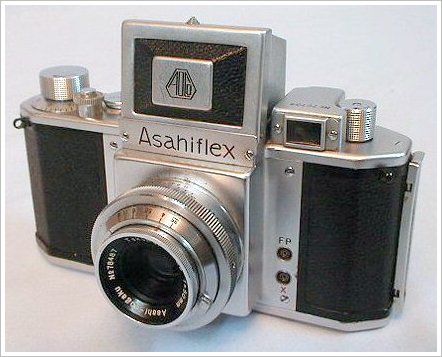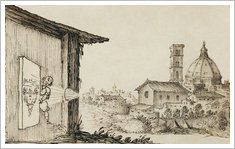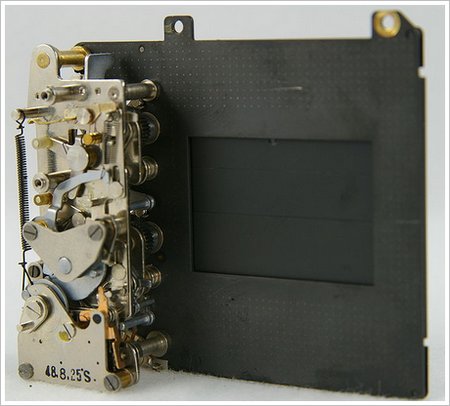The History of Camera Shutters
Author: Gaurav Birla September 1, 2010 No Comments
Different shutter mechanisms have been used over time to help photographers control the exposure of their images. Here are some of them and a look at today’s shutters. The basic act of taking a photograph involves allowing light to strike a photosensitive material in a controlled manner. At its simplest, the act of cutting a hole in a thin material will allow a bright object to be projected onto a parallel surface like a wall. The vagaries of Physics cause the image to be inverted as light beams, travelling in a straight line, converge on the hole and continue onward to the final surface.
The Camera Obscura
 This process was first described as early as the 5th century BC by the Chinese philosopher Mo-Ti, who recorded the projection of an image in a darkened room which he called the, ‘Locked treasure room’. Similar optical theories were expounded by Aristotle in the 4th century and by Leonardo Da Vinci during the Renaissance. This type of device was termed the, ‘Camera Obscura’ in the 17th century by a German astronomer Johannes Kepler.
This process was first described as early as the 5th century BC by the Chinese philosopher Mo-Ti, who recorded the projection of an image in a darkened room which he called the, ‘Locked treasure room’. Similar optical theories were expounded by Aristotle in the 4th century and by Leonardo Da Vinci during the Renaissance. This type of device was termed the, ‘Camera Obscura’ in the 17th century by a German astronomer Johannes Kepler.
In 1727, a German professor Jihann Heinischulze discovered that silver nitrate darkened on exposure to light. However, it was not until almost a century later, when French lithographer Joseph Nicéphore captured an image through an eight hour exposure onto coated glass that photography was truly born.
Much of the research after this time was to improve the quality and sensitivity of the light sensitive media being used. As the exposure time required to record an image shortened dramatically, a system was required which allowed controlled the amount of light which was exposed to the recording medium. The mechanism developed was the shutter.
Early Shutters
 Initially, these were as simple as a cap being removed from the front of the lens and replaced at the appropriate time; however, this became unworkable as plate and later film sensitivity increased. The first mechanism recognizable as a shutter was developed in 1845. Two French physicists, Fizeau and Fucault developed a device based on a guillotine in order to photograph the Sun. It was made up of a board with a hole in the centre. When the shot was taken, the board would drop it into a slot in front of the lens. This exposed the plate for a short time as the hole passed in front of it. This technique was refined further by William English in the 1860’s, who created a system which took the guillotine principle, and added an adjustable aperture. This is recognized as the first focal plane shutter.
Initially, these were as simple as a cap being removed from the front of the lens and replaced at the appropriate time; however, this became unworkable as plate and later film sensitivity increased. The first mechanism recognizable as a shutter was developed in 1845. Two French physicists, Fizeau and Fucault developed a device based on a guillotine in order to photograph the Sun. It was made up of a board with a hole in the centre. When the shot was taken, the board would drop it into a slot in front of the lens. This exposed the plate for a short time as the hole passed in front of it. This technique was refined further by William English in the 1860’s, who created a system which took the guillotine principle, and added an adjustable aperture. This is recognized as the first focal plane shutter.
The 1880’s saw a sharp increase in the speed of film which made exposure control even more critical and led to the development of new techniques to more accurately control the amount of light which entered the camera.
Several methods were used during this period, mainly utilizing the tension of springs or elastic bands to control the light exposure, but the biggest breakthrough came with the development of a pneumatic timer, which was far more accurate and drove the technology for some time.
The first shutters which would be recognizable as such today started to be developed in the late 19th century and the early 20th century saw pneumatic control replaced by clockwork. Today, most shutter control is electronic although clockwork control is still widely used in large format cameras. The main shutter types in use today are the focal plane shutter and the ‘in lens’ shutter.
Focal Plane Shutter
The focal plane shutter is made up of a pair of cloth or metal blinds, which are situated in front of the film or sensor. When the button is pressed to take the shot, one blind move, exposing the sensor to light and is quickly followed by the second, which blocks the sensor, freezing the image.

The use of a two part mechanism allows for very high speed exposures as there is no requirement for an opening phase and a closing phase. The main drawback in this design is that to enable very high shutter speed, the second curtain follows extremely closely to the first, before it has completed its pass. This means that at any given point at the fastest shutter speeds, only part of the sensor is exposed to the light. When a flash is fired, it results in an uneven exposure as the pulse of light is only ‘seen’ by part of the sensor.
 This is the reason why DSLR cameras force a maximum shutter speed, (the flash synchronization speed), when a flash device is activated on the camera. In the photographs attached to this article, the first has a clear shadow to the right of the frame where the trailing curtain hasn’t completed its pass. The second photograph is taken at the correct flash synchronization speed.
This is the reason why DSLR cameras force a maximum shutter speed, (the flash synchronization speed), when a flash device is activated on the camera. In the photographs attached to this article, the first has a clear shadow to the right of the frame where the trailing curtain hasn’t completed its pass. The second photograph is taken at the correct flash synchronization speed.
The In Lens or Central Shutter
The, ‘in lens’ shutter located, appropriately enough, in the lens itself is made up of a number of metal blades, which open and close at the speed set for the exposure. The main issue with this design is again uneven exposure. When an exposure is made, the blades open from the centre, get to the required aperture and then close again. This means that the centre of the sensor is exposed to the light fractionally longer than the edges. This can lead to a vignetting effect, where the outside of the shot is darker than the rest.
A second issue with this arrangement is cost. The location of the shutter in the lens means that one is required for each lens a photographer owns. This can be offset to a certain degree by the fact that they are a simpler mechanism than a focal plane shutter and it may therefore carry a cheaper unit cost.
A further problem is the maximum speed which can be achieved by an In Lens shutter. Unlike the focal plane shutter, the in lens shutter has to travel twice as far, by performing both the opening and closing parts of the shutter cycle. This constrains the shutter speed, precluding the fastest exposures.
Conversely, there are no restrictions on flash synchronization across all shutter speeds with this type of lens.

